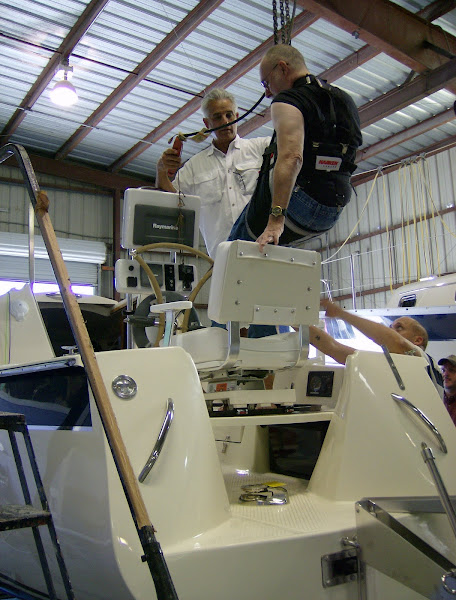
This business of getting a 59-year-old quadriplegic back into sailing is far more complicated and time consuming an endeavor than any sane gimp might want to embark upon, but that’s what adaptation is all about: living and enjoying life . . . even if getting at the heart of it is usually more difficult. My new Seaward 26RK was delivered on the 18th of January, in the midst of the coldest, longest, stretch of real winter anybody in the Florida Keys can remember. Day after day, the highs have been in the 50’s/60’s, and the lows have been in the 40’s on far too many nights. Here in the tropics, where the average daily temp is 82, that’s a serious challenge to any local, let alone an arthritic old geezer like me, but that’s just one of many reasons I’ve had nothing to blog about ‘till now.
Fortunately, we got a lot accomplished in the past month or so, even if practicing our sea
personship wasn’t included in the list. The big deal was electrical independence. Since my dream has been to explore the Keys at my leisure, and since I suspected that I’d need to stop and rest more often than most, I wanted to be able to crank up the microwave and the laptop whenever I wished . . . without having to crank up the 14hp Yanmar diesel inboard to keep the batteries up. I planned on having a solar panel from the beginning, but it didn’t take much to talk me into adding a wind generator too. While they were at it, I had them double my battery banks, add a more detailed battery monitor and a DC “cigarette plug” outlet, and move a few electrical items to more accessible locations. “Up ‘till now,” said Mike the electrician from S.A.L.T. in Marathon, “this has been Hake’s boat. My job is to help you make it
your boat.” And when he finished, Mike presented us with a complete electrical schematic of
our boat!
The other issue keeping us on the shore has been dock height. Here on the ocean side, tides range two to three feet, and our neighbor’s seawall (they’ve been graciously letting us dock there!) is meant more for luxury yachts than for little daysailers like ours, so in order for my boom hoist to lift me out of my wheelchair, the tide needs to be up, along with the boat’s topping lift. We used a block and a couple of cable clamps to move Nick Hake’s adjustable topping lift device another 18 inches up the topping line (Nick offered us a shorter topping line, but that meant bringing the mast down or sending Ellie up in my bosun’s chair, so we respectfully declined!), so now we can crank the boom high enough to function on this (or almost any?) dock, but the more severe boom angle makes the swing onboard and off a bit more precarious. It’s nothing Ellie and I can’t handle, but I don’t think I could manage it alone. So we’ve located a marina on the gulfside, and secured a slip where the dock is almost two feet lower, and the tide range is halved . . . easier for everyone. Our next outing will be the 22-mile trip up through Channel #5, under the Long Key bridge, and back down on the other side.
Yesterday, even the tide and the cold winds couldn’t keep us off the
Eleanor P, and so we loaded up and went to work on the most basic skill set necessary to turn us into sailors . . . motoring. It sounds strange, but learning how to handle your boat at or near the dock is where most newbies fail to do their homework. The result is a lot of damage to boats, docks, and people. We’ve watched some of the movie and YouTube boat crashing scenes and don’t want to add our clip to that particular wall of shame, so we spent two hours practicing on Lake Louise in forward, and in reverse, and doing dock approaches. I am so glad I spent a small fortune on bow thrusters, but I’m still going to need way more practice before I can bring the
Eleanor P in alone. Thankfully, yesterday’s outing taught me that I will be able to do it eventually.
Before quitting for the day, and even though the cold wind was doing a number on my neck and shoulders, I just had to go out to sea. I’ve never skippered a boat in the ocean before. I have countless hours in the Intracoastal Waterway, thanks to my time in the crabbing business up in central Florida, but aside from being a passenger on cruise ships and party fishing boats, I’ve never taken the helm and gone to sea. As the
Eleanor P slipped out of the causeway, though Hawk’s Channel, and out into open water, it was nearly impossible not to raise the sail, and had I not been cold to the bone, I probably would have done it. Next time, for sure!







